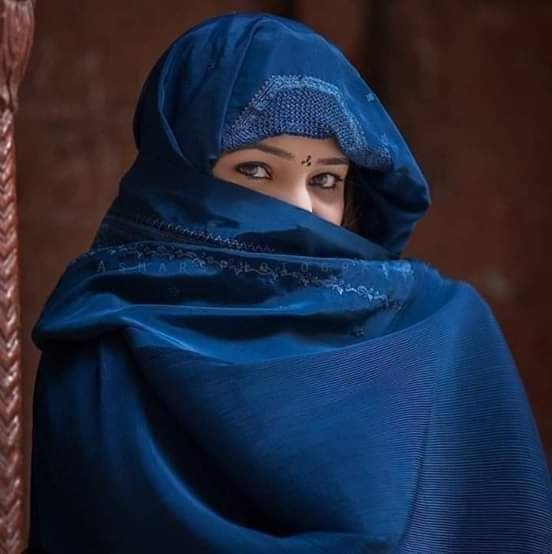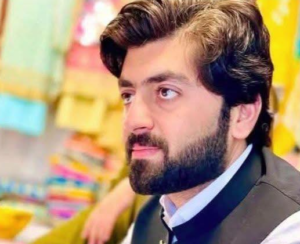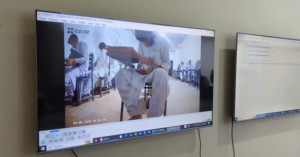Sheen Khaal or the blue or green dots, tattooed between the eyebrows or on the chin of young Pakhtun girls are traditional beauty marks in the Pakhtun culture. This custom was originally practiced as a way to protect ones from the evil eye. It used to be very common among the Pashtun ladies but today it is rarely seen on old age women or nomads usually called kochi women. Sheen Khaal is still considered as a beauty standard by many. In order to revive the tradition, some Pashtun women nowadays make temporary sheen khaal on their faces for special occasions.
Peots have praised this beauty mark in different songs. Sheen khaal is also used as a medical treatment for pain in the muscles and body in rural areas where no medical facility is available. A person, who masters this skill, takes a sewing needle and inject the same multiple times in the part having pain. The person then applies kohl/kajal as an antiseptic to stop the bleeding. The point later turns into a green or blue dot. This practice is similar to the Chinese traditional medicinal practice known as acupuncture.
Acupuncture involves the insertion of very thin needles through the skin at strategic points on the body. A key component of traditional Chinese medicine, acupuncture is most commonly used to treat pain. One major hypothesis is that acupuncture works through neurohormonal pathways. Basically, you put the needle through specific points in the body and stimulate the nerve. The nerve actually sends signals to the brain, and the brain releases neural hormones such as beta-Endorphins.
In Chinese acupuncture, though the needles are extremely fine, they sometimes hit small blood vessels, causing a minor bruise to form in that area. With the time it fades away but sheen khal last for the whole life. The sheen khal or the blue tattoo has a history of thousands of years in the region inhabited by the Pashtuns. This region is landlocked and surrounded by high mountains. This region is called as the land of beautiful people. The pakhtun are very beautiful people. Sheen Khal is the recognition mark of the Pashtun tribes. Women used to make sheen khal between their eyes on the forehead, on the cheekbones, on the chins or on the lips. Pashtun girls often make sheen khal before marriage because they believe that after marriage, Sheen Khal bring bad luck. And this bad luck may kill their husband or someone else in the family. Sheen khals are consider lucky only before marriage.
Some people used to make sheen khal on the foreheads of their young children because they believe it brings good luck and it may help skin to survive for long and avoid skin aging.
Shen khal are also used to treat patients. Not all women or men are expert in making sheen khal. In earlier times, there used to a women who was expert in making the tattoo, in almost every neighbourhood but with the passage of time, such people faded away.
The woman making shenkhal, combines two or four needles and gently inject them into the specific area of the face where the sheen khal is supposed to be made. When it starts bleeding, she would apply a small amount of the kajal/ kohl on the wound. For about eight hours, the redness fades, and a scar appears on the wound. In past, sheen khal was the only tool to increase beauty as it looks beautiful too. In Afghanistan, Balochistan, the former FATA and Khyber Pakhtunkhwa, every third elderly woman over the age of 60 may be having a blue dot on their foreheads, cheeks, or hands.
But now this practice is mostly abandoned and it has become a history. There are various reasons for this. The most important reason is the wars in the Pashtun region. These wars have brought various changes in the lives of the Pashtuns and forced them to live nomadic lives. In these nomadic tribes, the practice of sheen khal was common. Due to the wars, most of the nomadic tribes left their nomad’s life and settled near the cities and some people made the cities as their home. Due to this, the tendency to make sheen khal has decreased. Some people believe that religion has also a role behind the abandonment of this practice and they consider these sheen khal as haram. According to this school of thought, the one who has the sheen khal, would go to hell.
The sheen khal are also found in the Middle East and North Africa. Many great and revered poets from the pre-Islamic era used imagery of face tattoos in their poetry as a strong symbol of beauty. The Mu‘allaqāt, a collection of seven long poems from the pre-Islamic Arab world, has many references about tattoos and tattooed women in connection with beauty. Often referred to as ‘the poor man’s jewellery’, sheen khal were used a tool for decorating the body and face, acting as a more financially affordable alternative to gold and silver ornaments. The positioning of t sheen khal on the face complements the areas of a woman’s face considered the most beautiful, namely the lips and the eyes.
The practice of sheen khal is dying off earlier in Pakistan due to colonization, and later the proliferation of Madrasas in the region. In Afghanistan it didn’t really start to wane until the start of the Jihad against Russia and subsequent wave of refugees moving into Pakistan and gaining Islamic knowledge through the madrassas or the religious seminaries. Even a few decades ago these khals were very common as little people khew that these are forbidden.
The specific designs and places where they’re done differed by tribe, the elaborate ones that are often pictured weren’t actually common. More commonly they’d just be circles. The practice is dying off though, as people are being made more Islamized.
Mamarha Afridi







